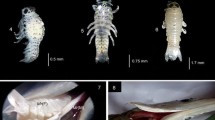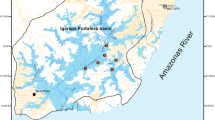Abstract
The present paper reports the site of attachment preference, overlapping and partitioning of niche among different life stages of parasitic isopod Cymothoa indica Schiöedte and Meinert, 1884 in the Gobiidae fish Glossogobius giuris (Hamilton 1822) collected from the Chilika lagoon, India. Out of 2113 host fishes, 176 were found to be infected by the parasites. Out of the 233 different life stages of the parasites examined, 89 were female, 104 were male, and the rests were juveniles. 100% of the females, 84.6% of the male and 72.5% of the juveniles were found to be attached to the buccal cavity, while the rest of the males and juveniles were attached to the branchial cavity. In most cases, there was niche overlapping, leading to competition for the resources. Females preferred more specialized niches as compared to males and juveniles. In a few instances, there is niche partitioning, as shown by the male and juveniles. There is a negative correlation between the number of parasites found in the body of the fishes and the weight of the host fishes. This manuscript also provides a brief description of the different life stages of this parasite in the above-mentioned host collected from the same lagoon.





Similar content being viewed by others
Data availability
All the specimens are deposited at the National Repository of Estuarine Biology Regional Centre, Zoological Survey of India, Gopalpur-on-Sea, which can be verified after requesting the Officer-in-Charge.
References
Altermatt F, Pearse IS (2011) Similarity and specialization of the larval versus adult diet of European butterflies and moths. Am Nat 178(3):372–382. https://doi.org/10.1086/661248
Baillie C, Welicky RL, Hadfield KA, Smit NJ, Mariani SD, Beck RM (2019) Hooked on you: shape of attachment structures in cymothoid isopods reflects parasitic strategy. BMC Evol Biol 19(1):1–11
Bouchard RW Jr (2004) Guide to aquatic macroinvertebrates of the upper Midwest. University of Minnesota, St. Paul, MN, Water Resources Centre
Bowman TE, Mariscal RN (1968) Renocila heterozota, a new cymothoid isopod, with notes on its host, the anemone fish, Amphiprion akallopisos, in the Seychelles. Crustaceana 1:97–104
Chilton C (1924) Fauna of Chilka Lake: Tanaidacea and Isopoda. Mem Indian Mus 5(12):877–895
Fokkema W, van der Jeugd HP, Lameris TK, Dokter AM, Ebbinge BS, de Roos AM, Nolet BA, Piersma T, Olff H (2020) Ontogenetic niche shifts as a driver of seasonal migration. Oecologia 193(2):285–297
Froese R, Pauly D (2022) FishBase. World Wide Web electronic publication. Available from: http://www.Fishbase.org, Version (02/2022). Accessed during January 2022.
Hata H, Sogabe A, Tada S, Nishimoto R, Nakano R, Kohya N, Takeshima H, Kawanishi R (2017) Molecular phylogeny of obligate fish parasites of the family Cymothoidae (Isopoda, Crustacea): evolution of the attachment mode to host fish and the habitat shift from saline water to freshwater. Mar Biol 164(5):1–5
Hernández JS, Montori A, Llorente GA (2019) Ontogenetic dietary shifts and food resource partitioning in a stream-dwelling Urodela community: mechanisms to allow coexistence across seasons. Russ J Herpeto 26(3):135–149. https://doi.org/10.30906/1026-2296-2019-26-3-135-149
Holt RD (2009) Bringing the Hutchinsonian niche into the 21st century: ecological and evolutionary perspectives. PNAS 17 106(2):19659–65
Horne BV (1982) Niches of adult and juvenile deer mice (Peromyscus Maniculatus) in seral stages of coniferous forest. Ecol 63(4):992–1003. https://doi.org/10.2307/1937239
Kiffner C, Lödige C, Alings M, Vor T, Rühe F (2021) Attachment site selection of ticks on roe deer, Capreolus Capreolus. Exp Appl Acarol 53(1):79–94
Levins R (1968) Evolution in changing environments. Princeton Univ Press, Princeton, NJ
Odum EP (1961) Fundamentals of ecology, Second Edition, W. B. Saundersm Company, Philadelphia and London, 27–30.
Pianka ER (2011) Evolutionary ecology. Seventh Edition – eBook, 240–266
Plaistow S, Siva-jothy MT (1999) The ontogenetic switch between odonate life history stages: effects on fitness when time and food are limited. Anim Behav 58(3):659–667
Purivirojkul W, Songsuk A (2020) New records of fish parasitic isopods (Crustacea: Isopoda) from the Gulf of Thailand. Animals 10(12):2298
Rameshkumar G, Ravichandran S (2013) Effect of the parasitic isopod, Catoessa boscii (Isopoda, Cymothoidae), a buccal cavity parasite of the marine fish, Carangoides malabaricus. Asian Pac J Trop Biomed 3(2):118–122. https://doi.org/10.1016/S2221-1691(13)60035-0
Ravichandran S, Vigneshwaran P, Rameshkumar G (2019) A taxonomic review of the fish parasitic isopod family Cymothoidae Leach, 1818 (Crustacea: Isopoda: Cymothooidea) of India. Zootaxa 4622(1):1–099. https://doi.org/10.11646/zootaxa.4622.1.1
Seth JK, Mohapatra SK, Mohanty SR, Behera RK, Mohapatra A (2021) Confirmation on the occurrence of Cymothoa indica, and first record of Norileca indica, with a note on new host records of Nerocila arres, and Nerocila depressa (Isopoda: Cymothoidae) from Odisha coast. India J Parasit Dis 45(4):944–951
Smit NJ, Bruce NL, Hadfield KA (2014) Global diversity of fish parasitic isopod crustaceans of the family Cymothoidae. Int J Parasitol Parasites Wildl 1 3(2):188–97
Székely D, Cogălniceanu D, Székely P, Denoël M (2020) Adult—juvenile interactions and temporal niche partitioning between life-stages in a tropical amphibian. PLoS One 15(9):e0238949
Trilles JP and Bariche M (2006) First record of the Indo-Pacific Cymothoa indica (Crustacea, Isopoda, Cymothoidae), a Lessepsian species in the Mediterranean Sea. Acta Parasitol 51(3), 223–230; ISSN 1230–2821
Turlure C, Van Dyck H, Schtickzelle N, Baguette M (2009) Resource based habitat definition, niche overlap and conservation of two sympatric glacial relict butterflies. Oikos 118(6):950–960
Acknowledgements
The authors are thankful to the support and facilities provided by Berhampur University, Odisha, India.
Funding
The work was supported by the Science and Engineering Research Board (SERB), Department of Science and Technology, Government of India (File No. EEQ/2021/000048) as a project grant to the corresponding Author.
Author information
Authors and Affiliations
Contributions
SKM and SS: sampling, data analysis and writing of the manuscript; JKS: conceptualisation of the idea, manuscript preparation and analysis.
Corresponding author
Ethics declarations
Consent for publication
All authors agreed for the publication of their data.
Conflict of interest
The authors declare no competing interests.
Additional information
Handling Editor: Una Ryan
Publisher's note
Springer Nature remains neutral with regard to jurisdictional claims in published maps and institutional affiliations.
Rights and permissions
Springer Nature or its licensor holds exclusive rights to this article under a publishing agreement with the author(s) or other rightsholder(s); author self-archiving of the accepted manuscript version of this article is solely governed by the terms of such publishing agreement and applicable law.
About this article
Cite this article
Mohapatra, S.K., Sura, S. & Seth, J.K. Overlapping and partitioning of niche among different life stages of the parasitic isopod Cymothoa indica in the host Glossoglobius guiris collected from the Chilika lagoon, India. Parasitol Res 121, 3217–3222 (2022). https://doi.org/10.1007/s00436-022-07641-1
Received:
Accepted:
Published:
Issue Date:
DOI: https://doi.org/10.1007/s00436-022-07641-1




